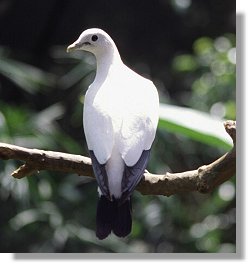Geoffrey Bay littoral scrub
The Geoffrey Bay littoral scrub is an important ecological community that helps support the abundance of wildlife in Arcadia and improve the quality of water flowing onto the fringing reef of Geoffrey Bay.
Littoral scrubs are rainforests by the sea and are characterised by many different tree species growing closely together to provide a canopy. This littoral scrub is growing on an historic beach ridge and has formed due to its protection from fire and seawater and having reasonable access to nutrients and fresh water. This has enabled the establishment of a high diversity of species.
Large native trees present include the Moreton Bay ash (Corymbia tessellaris) on the higher sandy soils, weeping paperbark (Melaleuca leucadendra) in the lower swale areas, plus Burdekin plum (Pleiogynium timorense), cluster fig (Ficus racemosa) and weeping cabbage palm (Livistona spp.).
In the dry season many species drop their leaves to conserve moisture. The leaf litter forms a thick layer of mulch over the sandy forest floor, which helps to retain moisture within the soil and keep the soil cool. Following good rain, a flush of new growth is produced, and once again the forest produces a shady canopy.
 |
Pied Imperial Pigeon |
This littoral scrub is an important refuge area for many native animals, such as the blue tiger and common crow butterflies, orange-footed scrub fowl and numerous reptiles, some of which are considered endangered. It is also a feeding and nesting area for the pied imperial pigeon (Ducula bicolor) (further information is available from the Nelly Bay Bird Habitat Reserve Interpretative Centre). This pigeon nests in the upper canopy trees and feeds on the fleshy rainforest fruits below. The pigeons digest the pulps around the seeds and then pass undigested seed through the gut. The undigested seeds germinate in the nutrient-rich moist leaf litter mulch. This is an important process in the dispersal of many rainforest plant species.
Natural drainage lines carry stormwater from the catchment through the scrub and into the marine environment. The low-lying topography and dense vegetation of the scrub help reduce the sediment and nutrient load of the stormwater and therefore improve the quality of the water flowing onto the adjacent coral reef.
Apart from its ecological values, the Geoffrey Bay littoral scrub is aesthetically pleasing. It provides a lush leafy backdrop for surrounding houses, acts as a buffer against noise and offers a visual screen. All these qualities are important for retaining the village-like atmosphere of Magnetic Island. |